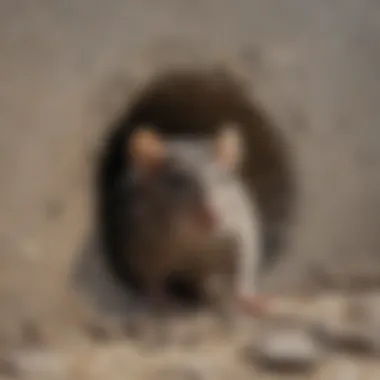Blocking Rat Holes: Effective Pest Control Strategies


Intro
Rats are notorious pests, capable of causing significant damage to properties and spreading diseases. Their ability to infiltrate homes and gardens makes it essential for homeowners to understand effective strategies to block their access points. Identifying rat activity in and around your home can prevent them from becoming a serious nuisance. This article details comprehensive methods to combat rat infestations, focusing specifically on blocking rat holes.
Understanding Pests
Definition of Pests
Pests are organisms that can harm humans, animals, crops, or structures. Among these, rats are particularly troublesome. They thrive in urban environments, seeking food, water, and shelter. The most common species associated with infestations include the Norway rat and the rooftop rat. Recognizing them and understanding their behaviors is vital in developing an effective pest control strategy.
Importance of Pest Identification
Identifying the specific type of pest is crucial. For instance, Norway rats are burrowing rodents, while rooftop rats prefer climbing and nesting in trees or roofs. Accurate identification informs your approach towards blocking entry points.
Prevention Techniques
Home and Garden Preventative Measures
Effective pest management starts with simple preventative measures:
- Seal Entry Points: Use materials like steel wool and caulk to block holes and gaps around the house. Rats can squeeze through small openings, so thorough inspection is essential.
- Maintain Cleanliness: Keeping your home tidy reduces attractants. Store food in sealed containers and dispose of waste properly.
- Regular Maintenance: Inspect the property regularly for signs of damage or entry points.
Seasonal Prevention Tips
Changes in seasons can affect rat behavior. In colder months, they seek warmth inside homes. During spring, they may venture outdoors for nesting. Adapting your strategy according to seasons can enhance your pest control efforts. For instance, during fall, ensure that woodpiles or outdoor clutter are minimized, as they provide shelter for rats.
Eco-Friendly Pest Control Solutions
Overview of Sustainable Practices
Approaching pest control in an eco-friendly manner is increasingly important. Sustainable practices involve minimizing chemical use that could harm the environment. This includes choosing natural materials for blocking entrances and employing humane traps for capturing pests.
Natural Remedies and Their Effectiveness
Some natural alternatives to traditional pest control methods are:
- Peppermint Oil: The scent of peppermint can deter rats. Spraying peppermint oil around entry points may help in keeping them away.
- Diatomaceous Earth: This natural powder can kill pests by dehydrating them. Sprinkle it around suspected entry points for added protection.
"Employing eco-friendly pest control methods not only protects your property but also contributes to a healthier environment."
Understanding Rat Behavior
Understanding the behavior of rats is critical in developing effective strategies for pest control. An in-depth comprehension of their habits can guide one in preventing infestations and in effectively blocking their entry points. Rats are not just random invaders; they are creatures of habit and instinct.
This knowledge can provide several benefits. First, it allows for strategic planning in securing locations around the home. Second, it helps in identifying potential weaknesses that could be exploited by these pests. Lastly, it offers insight into their reproductive patterns and survival strategies in diverse environments, which can further enhance the effectiveness of pest control measures.
Diet and Feeding Habits
Rats are omnivorous and their diet is quite varied. They consume grains, fruits, vegetables, and even scraps of food found in human habitats. The presence of easily accessible food will attract them, making it vital for homeowners to understand these feeding habits.
To deter rats, it is crucial to eliminate potential food sources by adopting proper waste management techniques. Here are some critical points regarding rat diets:
- Types of Food: They prefer high-calorie foods.
- Feeding Time: Most active during the night, which is when they search for food.
- Scavenging Behavior: Will often rummage through trash or nibble on pet food left outside.
By controlling food availability, the chances of attracting rats can be significantly reduced.
Reproduction Patterns
The reproductive capabilities of rats are another crucial aspect of their behavior. A female rat can reproduce as early as five weeks after birth. Typically, a single litter can consist of five to ten offspring, allowing populations to multiply rapidly. This high reproductive potential makes blocking rat holes even more essential. If an area is already infested, a quick response is necessary to prevent exponential growth.


Consider these factors in reproduction:
- Breeding Frequency: A female can breed multiple times a year.
- Gestation: The gestation period lasts about 21 to 23 days.
- Survival Rate: Under optimal conditions, young rats can survive adulthood quickly and begin breeding themselves.
Understanding these patterns is vital for reducing rat populations effectively.
Adaptability to Environments
Rats display remarkable adaptability to various environments. They thrive in cities, farms, and even near residential areas. This adaptability plays a significant role in their ability to find shelter and food. Notably, Norway rats tend to burrow, while roof rats prefer climbing. Recognizing their preferred habitats can help homeowners focus on securing specific areas of their properties.
Key aspects of rat adaptability include:
- Shelter Preferences: They will choose places that offer safety from predators and humans.
- Behavior Adjustments: Rats can modify their behavior based on human activity, becoming more active when areas are less frequented.
- Climate Resilience: They can survive in a range of temperatures, making them a persistent menace.
By understanding these adaptive capabilities, strategies can be developed to limit their access and control their populations.
An informed approach to rat behavior is a cornerstone of effective pest control initiatives.
Identifying Rat Holes
Identifying rat holes is a crucial step in preventing infestations and mitigating damage to property. Recognizing where rats are entering a home can help homeowners take proactive measures to block these entryways before a larger problem develops. Understanding the physical characteristics of rat holes, knowing common locations where they tend to appear, and employing effective assessment techniques are all vital components of this process. By properly identifying rat holes, one can reduce the risk of health hazards and economic losses associated with rat infestations.
Physical Characteristics of Rat Holes
Rat holes have distinct physical features that can help in their identification. Typically, these holes are about 2 to 4 inches in diameter. They may have a clean, smooth appearance around the edges, as rats often gnaw at the surrounding materials to facilitate easier passage. Additionally, soil or debris may be present outside the exit; this can include droppings or gnawed materials such as wood or plastic. Observing these details can assist in confirming the presence of rats.
Important: Look for signs such as oily marks or body rubs along walls near the holes; these are indicators that rats use a particular path consistently.
Common Locations for Rat Holes
Rats often seek shelter near food sources and comfortable habitats. Identifying common locations for rat holes can aid prevention.
- Perimeters of buildings: Check areas where structures meet the ground. Cracks and gaps in foundations are frequent entry points.
- Near dumpsters: Trash storage areas attract rodents. Inspect around these spaces for hidden entryways.
- Gardens and lawns: Rats burrow in soft soil, making gardens a potential nesting site. Look for holes in lawns or garden edges.
- Basements and crawl spaces: These areas are dark and warm, which make for ideal rat homes.
Homeowners should conduct regular inspections of these spaces to catch infestations early.
Assessment Techniques for Detection
Several techniques can be employed to effectively assess the presence of rat holes in and around a property.
- Visual Inspections: Walk around the property and look for any signs of rat activity. This includes actual holes, droppings, and tracks.
- Tracking Powder: Sprinkling tracking powder near suspected rat paths can help confirm activity. If rats are present, footprints will appear in the powder.
- Camera Traps: Setting up motion-sensor cameras can help in capturing images of rat activity, particularly in hidden areas.
- Check around Entry Points: Focus on areas around doors, windows, and vents. Any gaps found should be examined closely for signs of rat access.
Using these techniques enables one to gather a clear understanding of the extent of any infestation, which is essential for deciding on effective pest control strategies.
Materials for Blocking Rat Holes
Blocking rat holes is a vital aspect of pest control, ensuring that these rodents do not infiltrate homes and gardens. Selecting the right materials to seal entry points not only prevents unfortunate encounters but also maintains a healthier living environment. This section discusses various options available, considering their effectiveness, adaptability, and potential advantages, enabling homeowners to make informed decisions.
Metal Grates and Screens
Metal grates and screens are a robust solution for blocking rat holes. These materials are often constructed of durable metals like steel or galvanized iron, providing resistance against gnawing. They can be used to cover holes in walls or ground gaps where rats typically enter.
Advantages of using metal include:
- Durability: Metal does not deteriorate over time and withstands the elements.
- Physical Barrier: It effectively deters rats and other wildlife, maintaining the integrity of your property.
- Versatility: Metal screens can be cut and shaped to fit various openings, ensuring a tight seal.
Installing metal grates might require tools to cut and secure them properly. Some homeowners might prefer hiring a professional to ensure correct implementation and long-term results.
Cement and Mortar Solutions


Cement and mortar are classic and sturdy solutions for blocking rat holes, particularly for larger openings. These materials create a strong, solid barrier that can effectively eliminate access points. Cement is long-lasting, resistant to weathering, and when done properly, can blend well with existing structures.
Before applying mortar or cement, it is essential to:
- Clean the hole area to eliminate nesting materials or signs of rodent activity.
- Ensure any active rats are removed safely, as sealing an entry while an infestation exists can lead to significant problems.
The main benefits of cement include:
- Long-term Effectiveness: Once set, it is several times harder to breach than softer materials.
- Cost-Effectiveness: A relatively low-cost solution for blocking multiple entry holes.
- Customizability: Homeowners can adjust consistency and mix according to the specific needs of the application.
Eco-Friendly Sealants
Eco-friendly sealants are becoming increasingly popular in rodent control strategies. These products are typically made from natural ingredients, making them safe for pets and children, which is a significant consideration for many homeowners. They offer a flexible barrier against pests, allowing for movement in foundational structures while still preventing entry.
Some points to consider when using eco-friendly sealants include:
- Non-Toxic Materials: Many sealants contain organic components, reducing the risk to environmental health.
- Elasticity: These sealants allow for building movement and expansion without cracking, maintaining their sealing properties over time.
When applying eco-friendly sealants, homeowners must ensure that the surface is clean and dry. Additionally, multiple layers might be necessary for enhanced efficacy.
In summary, choosing the right materials for blocking rat holes is crucial in pest control strategies. Consider durability, application method, and safety to ensure the chosen solution not only fits the needs of your home but also contributes to a sustainable, pest-free environment.
Practical Steps for Blocking Rat Holes
Effective pest control hinges on the ability to block entry points that rats use to infiltrate homes and buildings. Practical steps for blocking rat holes are vital in establishing a barrier against these pests. Not only do these steps help in keeping rats at bay, but they also promote a healthier living environment. Addressing the problem early on can save homeowners from significant damage and health risks associated with rodent infestations.
Initial Inspection and Assessment
The initial phase of pest control involves a thorough inspection of the property. Assessing the environment allows homeowners to pinpoint potential entryways for rats. Here are key aspects to consider during this phase:
- Visual Clues: Look for signs of rat activity, such as droppings, nesting materials, or tracks. Rat holes may be found around foundations, utility lines, or baseboards.
- Location Analysis: Identify locations where food and shelter are abundant, as these attract rats. Areas close to dumpsters or stored materials are often prime spots.
- Health Risks: Understand the health risks that come with rat infestations. Rat droppings and urine can spread diseases, making it crucial to act promptly.
Taking the time to conduct a comprehensive inspection lays the groundwork for effective pest control strategies.
Choosing the Right Blocking Material
Selecting appropriate materials for blocking rat holes is essential. The right choice can significantly enhance the effectiveness of pest control efforts. Consider the following materials:
- Metal Grates and Screens: These are durable options that prevent rats from gnawing through. They work well for larger openings.
- Cement and Mortar Solutions: Use these for sealing small cracks. They provide an impermeable barrier that is difficult for rats to breach.
- Eco-Friendly Sealants: As sustainability gains importance, opting for non-toxic sealants can be an excellent choice. These materials often have reduced environmental impact and can effectively block entry points.
When choosing the right material, take into account the size and location of rat holes as well as any potential environmental considerations.
Step-by-Step Blocking Process
The process of blocking rat holes can be intricate but is essential in ensuring a pest-free environment. Follow these steps for effective action:
- Gather Materials: Collect all necessary blocking materials and tools before beginning the work. This preparation prevents unnecessary delays.
- Close Off Entry Points: Start sealing visible rat holes using the selected materials. Ensure that all gaps and cracks are adequately filled.
- Secure Surrounding Areas: After sealing the holes, inspect and secure other areas that may serve as entry points. This includes reinforcing boundaries around foundations and doors.
- Regular Maintenance: After successful blockage, it is important to regularly assess the property for new rat activity. Regular maintenance protects your home against future infestations.
"Blockading potential breaches is crucial to keeping rats out and ensuring a safe living space."
Using these practical steps ensures a systematic approach to blocking rat holes, ultimately helping to mitigate pest issues effectively.
Preventive Measures for Rats
Taking preventive measures against rats is essential for effective pest control. By implementing strategies that deter rats from invading your living spaces, you not only protect your property but also maintain a healthier environment. Understanding specific elements of prevention can save time, effort, and money in the long run.
Creating an Unfriendly Environment
To start, creating an unfriendly environment for rats is paramount. Rats seek shelter, food, and water, so disrupting these essentials will encourage them to find another habitat. Begin by assessing your property for potential nesting sites or hiding places.


Be sure to:
- Maintain your garden: Regularly trim shrubs and clear debris that may provide shelter.
- Seal cracks and crevices: Inspect your home for gaps in walls, foundations, and at utility entry points that rats might exploit.
- Use landscaping wisely: Keeping a distance between vegetation and your home discourages nesting near structures.
By making your property less inviting, you contribute significantly to reducing the risk of infestation.
Waste Management Techniques
Next, consider waste management techniques. Properly managing waste is crucial for discouraging rats. Leaving food scraps and garbage accessible invites pests into your life. Implement these best practices:
- Use secure trash bins with tight-fitting lids. This keeps food waste contained.
- Compost responsibly: If you compost, ensure it is kept sealed and does not attract pests.
- Clean up spills immediately: Pet food, fallen fruit, and other human food remnants should not linger.
Efficient waste management can remove food sources that rats rely on, significantly reducing attraction.
Proper Food Storage Practices
Finally, focus on proper food storage practices. Rats are highly resourceful and can locate food even in well-sealed containers. To minimize this risk:
- Store food in airtight containers: Choose glass or hard plastic containers style to keep contents fresh and away from pests.
- Avoid leaving pet food out overnight: Feed pets only during designated times.
- Check for leaks regularly: Fix any leaks or moisture that could attract rats seeking water sources.
By adopting these practices, you enhance your defenses against possible rat infestations.
Preventing rat infestations requires consistent efforts and awareness. By creating a hostile environment, managing waste effectively, and practicing good food storage, the odds of attracting these pests into your home are greatly reduced.
Community Impacts of Rat Infestations
Rats are more than just nuisances in urban and rural settings. Their presence poses significant risks to public health, economic stability, and environmental integrity. Understanding these impacts is crucial to appreciating why blocking rat holes and preventing infestations is imperative not only for individual households, but also for communities at large.
Health Risks Associated with Rats
Rats are vectors for numerous diseases affecting humans and pets. These include leptospirosis, hantavirus, and salmonella, among others. The risk of transmission comes from contact with rat droppings, urine, and bites. Even indirect exposure can occur when contaminated materials are mishandled.
Infestations can escalate quickly in densely populated areas, making it easier for diseases to spread. In schools and communities where children play, the presence of rats can lead to health crises that require significant public health responses. Preventing access to homes through effective blocking strategies helps mitigate these risks.
Economic Consequences of Infestations
Rats can inflict considerable economic damage. The costs associated with property damage escalate when infestations go unchecked. They may chew through wires, insulation, and building materials, leading to expensive repairs and increased energy costs.
Additionally, businesses can suffer from the negative perception associated with rat problems. A single rat sighting can deter customers and lead to a decline in revenue. For local economies, particularly those relying on tourism, a reputation for pest issues can be detrimental. Ultimately, the financial burden extends beyond immediate repair costs to include loss of business and increased healthcare expenses due to rat-associated illnesses.
Environmental Considerations
The ecological footprint of a rat infestation is not negligible. Rats contribute to the decline of native wildlife by preying on young birds and other small species. Their foraging behavior can lead to the destruction of vegetation, disrupting local ecosystems and habitats.
Efforts to manage rat populations often rely on chemical pest control solutions, which can introduce harmful substances into the environment. This creates a paradox where the solution to the infestation poses additional ecological risks. By focusing on sealing entry points and preventing infestations, communities can maintain biodiversity and promote healthier environments.
"Preventing rat infestations is not just a matter of home safety but a broader issue affecting public health, economic vitality, and environmental health."
End and Recommendations
In addressing the challenge of rat infestations, the importance of properly blocking rat holes cannot be overstated. Successfully sealing these entry points not only protects your home from potential damage but also plays a crucial role in maintaining hygiene and public health. Given the extensive impact that rodent populations can have, understanding effective strategies for pest control becomes essential for homeowners and property managers alike.
Summary of Effective Strategies
To summarize, blocking rat holes involves several, well-defined steps. Firstly, conducting a thorough inspection of the property is crucial. Look for signs of rat activity, such as droppings or gnaw marks, as these indicators could point to larger infestations. Secondly, choosing the appropriate materials for blocking is key; options include metal grates, cement, and eco-friendly sealants. Each material has its benefits and should be selected based on the specific needs of your property. Finally, implementing a systematic blocking process will significantly reduce the likelihood of rats returning.
- Inspect and Assess: Examine your surroundings for signs of rat activity.
- Select the Material: Choose between metal grates, cement, or eco-friendly options.
- Apply Techniques: Follow systematic application methods for effective blocking.
"Consistent effort in sealing entry points is your best defense against rats."
Encouragement of Sustainable Practices
The shift towards sustainable practices in pest control is paramount. Homeowners are urged to consider environmentally friendly materials whenever possible. By opting for options such as eco-friendly sealants, you not only protect your living space from pests but also contribute positively to the environment. This mindful approach helps in reducing chemical exposure and supports a healthier ecosystem.
In addition, routine maintenance and proactive waste management are vital. Keeping your surroundings clean and free from attractants will discourage rodents from entering your property. This dual approach—effective sealing and sustainable practices—creates a robust barrier against infestations.



